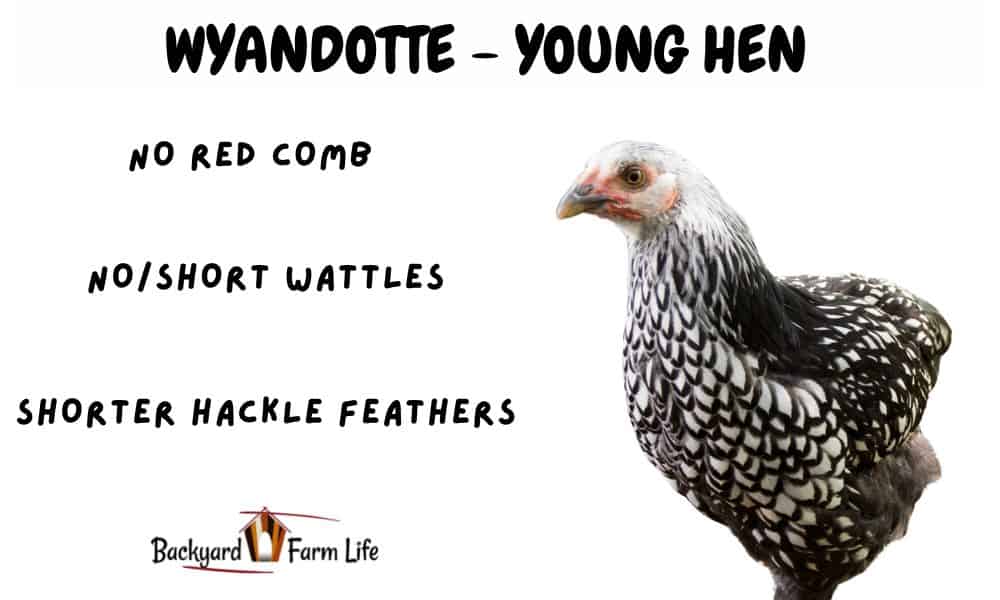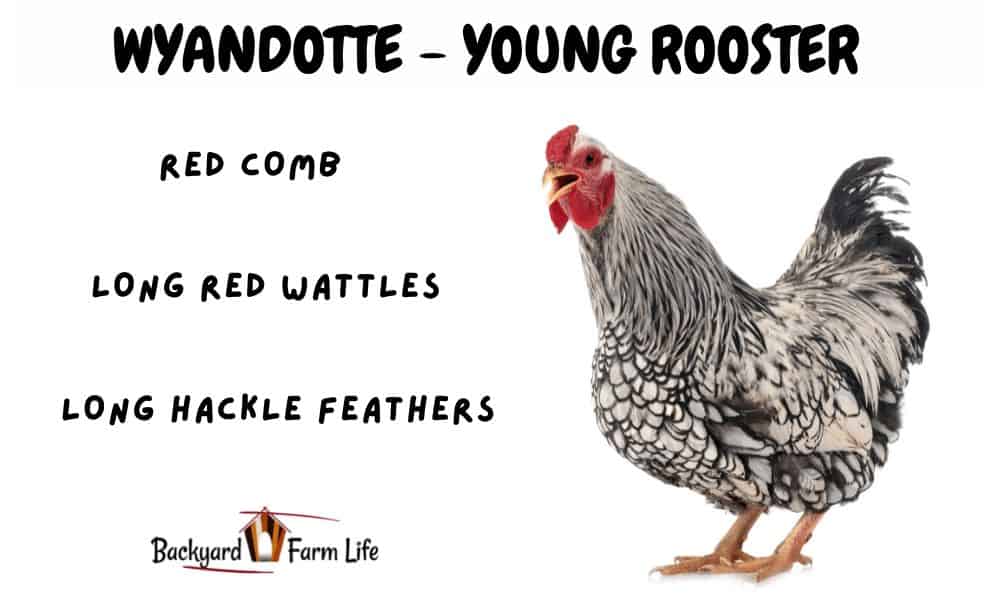Although their true origins have never been documented down to an exact place and time, Wyandottes have been around for hundreds of years.
But, it wasn’t until fairly recently that you could reliably breed blue-laced red Wyandottes, yielding one of the most beautiful, striking varieties, truly standing out amongst all others.
So, if you’re lucky enough to raise some of your own, well, you pretty much hit the jackpot.
Of course, for any new chicken owner or for those adding more chicks to their existing flock, it’s vitally important to identify if you’re raising hens or roosters, so you can plan your flock accordingly.
Here’s the most reliable way to tell a blue-laced red Wyandotte hen from a rooster and the unique characteristics and behaviors that each posses.
Contents
Here’s The Basics Of Blue Laced Red Wyandottes

If you already own blue-laced red Wyandottes, chances are you have a good handle on the basics.
But, here’s what we would consider the essential knowledge you should know about these beauties. After all, given their stunning appearance you’re bound to get asked about them all the time, so you better be equipped to answer them!
Origin
Some chicken enthusiasts literally get into arguments about this chook’s origins. However, the consensus is that Wyandottes themselves were first developed while breeding Dark Brahma and Spangled Hamburgs.
The original color is the wonderfully beautiful Silver Laced Wyandotte, but there are now over a handful of recognized varieties, including the highly sought-after blue-laced red Wyandotte!
Appearance
In general, Wyandottes are considered a medium-large breed, boasting thick plumage and a robust frame.
As for blue-laced red Wyandottes, their stunning red bodies laced with distinctly blue-speckled feathers, blue body feathers, and blue tail feathers make them visually striking.
They typically have yellow beaks and feet, and standard red wattles, combs, and earlobes.
Egg Characteristics
Although traditionally a dual-purpose bird (raised for meat or eggs), the majority of chicken owners raise these beauties for their eggs and companionship.
Luckily, blue-laced red Wyandottes are rather good at laying eggs, producing roughly 200 eggs per year on average.
Their eggs are medium to large-sized, brown in color, but they can sometimes lay speckled eggs too!
How To Tell The Difference Between Blue-Laced Red Wyandotte Hens & Roosters


I’ve got some bad news for all those eager chicken owners who are dying to find out if their young blue-laced red Wyandotte is a Henry or a Henrietta. Unfortunately, you’ll have to wait until your chicks are at least 8-12 weeks before you can really tell them apart based on their physical appearances.
However, from as young as 8 weeks old, blue-laced red Wyandottes (and all Wyandottes for that matter), start showing some visual differences between the hens and roos.
Here’s how you can tell the difference between your blue-laced red Wyandotte hens and roosters:
- Males begin growing their combs and wattles from as young as 8 weeks old, whereas most females take at least 16 weeks to show theirs.
- From 12 weeks old the male’s hackle feathers will be visually longer and more pronounced than those on a female Wyandotte.
- From 16 weeks, Wyandotte roos will stand taller and start to appear visually larger than their female counterparts.
Behavioral Differences Of Blue Laced Red Wyandotte Hens & Roosters
Aside from the visual differences between blue-laced red Wyandotte hens and roos, you should be able to observe some behavioral differences too, some more obvious than others!
Temperament
In general, blue-laced red Wyandottes are considered to be highly domesticated, friendly, approachable, and perfect for backyard farming and companionship.
Between the hens and roos, well, from as young as 16 weeks you may start noticing some more dominant behaviors from any roos in the flock.
This can come in the form of light pecking (establishing order), eating first, leading the flock, and sitting the highest on the roost.
On the other hand, Wyandotte hens normally remain docile, timid, and happily submissive.
Crowing & Egg Laying
It goes without saying, but it’s pretty clear you’ve got yourself a Wyandotte hen if she starts laying eggs!
Really though, you can expect any blue-laced red Wyandotte hens to start laying eggs from as young as about 6 months old.
Blue-laced red Wyandotte roosters will start to crow from as young as four to five months old, another clear sign you’ve got a roo in the flock!
Are Blue-Laced Red Wyandotte Roosters Aggressive?
Although much of a chicken’s temperament can come down to the individual chicken, in general, blue-laced red Wyandotte roosters are not considered aggressive.
I must admit however, I do know of a few overly protective Wyandotte roosters, who occasionally give stern warnings to others than share their backyard (pets, strangers, etc.).
So although they’re not overly aggressive, they’re not the gentlest roosters of them all. Still, I would encourage any new chicken owner who has ended up with a blue-laced red Wyandotte rooster to give a go at raising them before immediately deciding to rid of them.
After all, roosters need love too, right?
Final Thoughts
There are so many reasons to love blue-laced red Wyandottes.
Being dual-purpose breeds, you really can raise them for any single purpose you want, whether it’s for meat farming, egg production, backyard companionship, or for their unique, striking appearance.
If you’re raising Wyandottes from baby chicks, you can start to build a case for which may be a rooster and which may be a hen from as young as 8 weeks old by paying close attention to their wattles, combs, and hackle feathers.
As they grow up, pay attention to their overall size, any early attempts at crowing, and any flock-leading, confident behavior.
If you ARE raising these beauties, we would love to see them. Head on over to our Facebook page and send us a few pictures – we will happily share them with our chicken-loving community!
